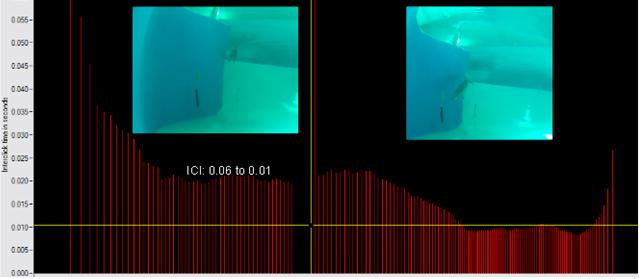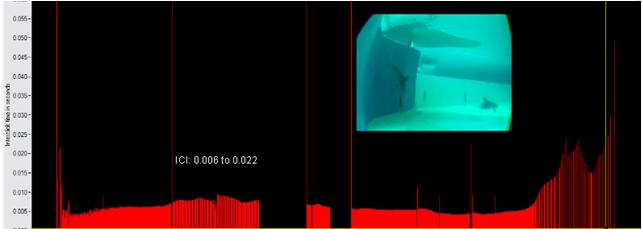Landmark use and frequency
A total of 33 click trains were recognized. A total of 101 seconds of click trains were investigated, and 87 seconds of video were used to investigate behaviours during these recordings.
17 events were recognized as decreasing ICI type click-trains, having an average ICI of 40 – 10ms, of which 12 of these click-trains ended with a buzz (ICI below 10ms). Three events were recognized as increasing ICI type click trains, having an average ICI of 14 – 60ms. 13 events were recognized as constant type click trains, with an average ICI of 29ms. Two constant type click-trains were recognized as a buzz, having an ICI of below 10ms.
During rest a total of 50 minutes of video was used, during which one or more dolphins were present in the deep area of the pool, whilst pointing towards the device for a total of 34.19 min. A total of 15 click trains were recorded during this period of time, having an ICI between 4 – 30ms, typically a constant, buzz or decreasing/increasing (not locked on target) type click-train was seen. Between 17.14 and 18.18 on the 9th of October, no clicks were recorded at all even though the dolphins were swimming past the device repeatedly.
Percentages of no landmarks used (below 50 clicks per hour recorded) and when landmarks where possibly used (more than 1800 clicks per hour recorded) during morning (06.00-12.00), afternoon (12.00-18.00), evening (18.00-00.00) and night (00.00-06.00) were calculated. The full database from August till October was used for the calculations.
During night and morning the possibility that the dolphins use the devices as landmarks is highest. During evening time the possibility that the dolphins use the devices as landmarks is lowest.



Responsible for this page:
Director of undergraduate studies Biology
Last updated:
06/19/15
